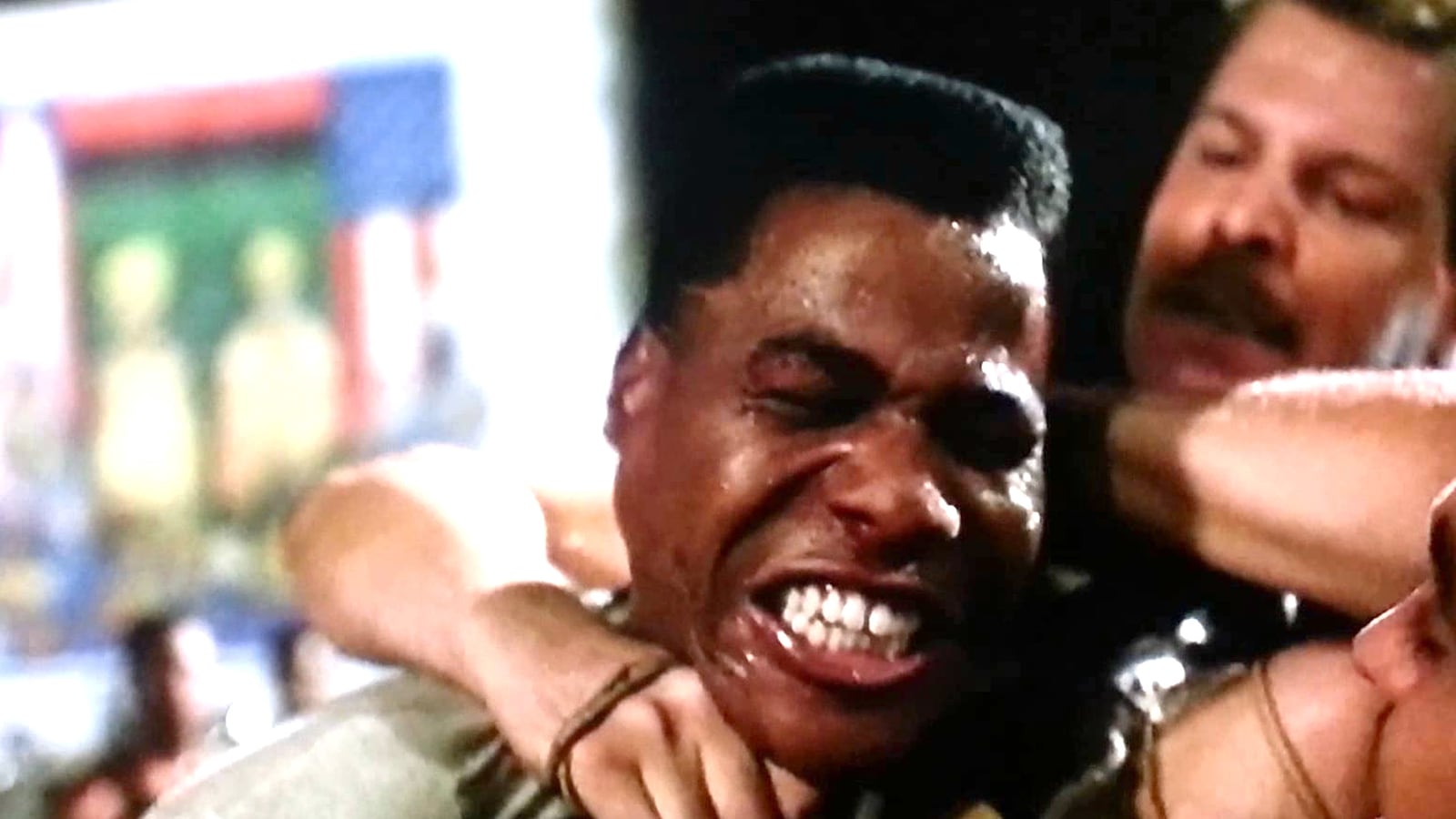It was a day like any other. On the afternoon of July 17, Eric Garner was loitering outside of a beauty supply store in the Tompkinsville section of Staten Island. At 6-foot-3 and 350 pounds, he was indeed a mountain of a man, but neighbors and friends knew him as “Big E,” a friendly neighborhood peacemaker. And earlier that day, the 43-year-old had earned the précis, breaking up a skirmish by the Staten Island Ferry. Despite his imposing physique, Garner suffered from myriad health issues, including diabetes, sleep apnea, and a debilitating case of asthma. His breath became so strained that he was forced to quit his job as a horticulturalist for the parks department. In order to help support his wife and six children, Garner would hawk “loosies”—individual and untaxed cigarettes—around the neighborhood, leading to regular harassment by the NYPD. At 4:45 p.m., he was approached by Justin Damico, a plainclothes cop, and another officer, Daniel Pantaleo, outside the store.
“Every time you see me, you want to mess with me,” Garner exclaimed, short of breath. “I’m tired of it. It stops today… I’m minding my business, officer, I'm minding my business. Please just leave me alone. I told you the last time, please just leave me alone.” The officers approached Garner and tried to grab hold of him, but he swatted their hands away. “Please… Please, don’t touch me. Do not touch me,” he screamed.
Then, Officer Pantaleo approached Garner from behind and put him in a chokehold—a move prohibited by the NYPD patrol guide since 1993—and, along with the help of several other policemen, brought Garner down to the sidewalk. The last words he spoke were “I can’t breathe,” which he repeated nine times as Pantaleo used his hands and knee to push Garner’s head firmly against the pavement. He was pronounced dead at a hospital an hour later.
Video of the horrific episode was captured by a bystander, Ramsey Orta, who then sold it to the New York Daily News. It soon went viral, with the public demanding justice. An autopsy by the city’s medical examiner showed that the cause of Garner’s death was “compression of neck (choke hold), compression of chest and prone positioning during physical restraint by police,” according to Julie Bolcer, a spokeswoman for the medical examiner’s office. It was ruled a homicide. Officer Pantaleo had also been sued twice in the past for alleged racially motivated misconduct in the line of duty. In one instance, Pantaleo and his fellow officers allegedly made two black men strip naked, squat on the street, and slapped their genitals whilst searching for drugs. The incident occurred just one mile from the Garner incident. The men filed suit against the city, which settled with them for $30,000.
And yet, on December 4, a New York grand jury decided not to indict Officer Pantaleo in Garner’s death. Protesters took to the streets of New York City to condemn the decision, while Garner’s widow, Esaw Garner, vowed to “get justice for my husband because he should not have been killed in that way.”
For many New Yorkers (and beyond), the cruel fate of Eric Garner recalled that of Radio Raheem, the boombox-carrying gentle giant portrayed by Bill Nunn in Spike Lee’s zeitgeisty 1989 film Do the Right Thing. After being called a “nigger,” by Sal the pizza man, a fight breaks out. When the NYPD arrives on the scene, a white officer places Raheem in a chokehold from behind, raising his body up in the air with his nightstick, and killing him. Lee even crafted a remix video splicing footage of Garner’s death with that of Raheem’s.
In Do the Right Thing, as the policeman squeezes the life out of Raheem, one of the onlookers can be heard shouting, “They did it again… just like Michael Stewart.” That’s because the death of Raheem was inspired by the tragic story of Stewart who, like Garner, was cut down by New York law enforcement and whose case ran into problems with the grand jury. Jonathan Moore, a famed civil rights attorney who represented the Stewart family in a subsequent suit against the city, is representing Garner’s family.
At 2:50 a.m. on September 15, 1983, Michael Stewart was spray-painting a wall at the L train’s First Avenue subway station. He was a black, 135-pound art student at Pratt Institute, as well as an aspiring model. New York City Transit cop John Kostick observed Stewart graffiti “RQS” on the wall, and after approaching him, said he surrendered without conflict. “Hey man, you got me,” Stewart said, according to Kostick. The 25-year-old was on his way home to the Clinton Hill neighborhood where he resided with his parents, and his father was a retired MTA maintenance worker.
According to Kostick, while awaiting a van to transport Stewart to the nearest police station, his mood changed. He sprinted from him, and fell to the ground. Once inside the van, several officers allege they subdued him en route to the District 4 transit police station in Union Square. Stewart allegedly tried to run again when they arrived at Union Square. Twenty-three Parsons students later claimed to have observed a struggle between Stewart and the transit police outside the District 4 station, with student Rebecca Reiss alleging she heard him shriek, “Oh my God, someone help me… What did I do? What did I do?” Stewart was eventually booked at the station for resisting arrest and unlawful possession of marijuana (a single joint), and was then hogtied with an elastic strap, and transported to Bellevue for psychiatric evaluation. By the time he arrived there at 3:22 a.m., with a blood alcohol content more than twice the legal limit, he was comatose. He died 13 days later.
An initial autopsy concluded that Stewart’s injuries, which included facial and wrist bruises, didn’t contribute to his death. New York medical examiner Dr. Elliott Gross instead ruled that he died of heart failure. Attorneys representing Stewart’s family contested the results, claiming he died as a result of being choked by officers within those 32 minutes between his arrest and arrival at Bellevue. Black community leaders picketed the office of then-Manhattan District Attorney Robert M. Morgenthau. On November 2, Dr. Gross changed his diagnosis, claiming that Stewart died as a result of “physical injury to the spinal cord in the upper neck,” but declined to specify further, saying, “There are a number of possibilities as to how an injury of this type can occur.”
The first grand jury indictment against the officers involved was thrown out seven months into the investigation because one of the grand jurors had, according to The Times, engaged in “supposed misconduct” by conducting his own private investigation into the cause of Stewart’s death, and was “the first known case in the country in which an indictment was thrown out because of a grand juror's supposed misconduct.”
A second grand jury took up the case in February 1984, and indicted arresting officer Kostick and the officers who transported Stewart to Bellevue in the police van, Herny Boerner and Anthony Piscola, with criminally negligent homicide, assault, and perjury. “Because no witness was able to identify a specific officer who might have delivered the blows, these three defendants were accused not of striking Mr. Stewart, but of allowing him to be beaten while he was in their custody,” reported The New York Times. It was the first time the “omission theory” of liability was tested in a New York State court, which, according to The Times, “holds a person responsible when he is able to act but fails to carry out a legal duty to do so. The theory was used to buttress the charge of criminally negligent homicide, which occurs when someone fails to take reasonable steps to prevent a death.”

Meanwhile three other officers, Henry Hassler, James Barry, and Susan Techky, who had testified that they did not witness the other officers beat Stewart, were charged with perjury.
The trial before the State Supreme Court began on July 18, 1985, the 23 Parsons students said they observed a struggle between Stewart and Transit police on the night of his death but they were hazy on the details, presumably because the incident had occurred nearly two years prior. Three medical experts also took the stand and offered differing theories on Stewart’s cause of death.“Dr. Gross attributed the death to a combination of factors - acute intoxication, police restraint and '’blunt force trauma,’” reported The Times. “The Medical Examiner of Massachusetts, Dr. Brian D. Blackbourne, cited force to the neck and subsequent asphyxia as the cause of death. And Dr. Thomas B. Graboys, a Boston cardiologist, testified that it was a blow to the chest or side that had led to Mr. Stewart's death.”
On November 24, 1985, the five-month long trial ended with an all-white jury acquitting the six indicted police officers—a verdict which drew outrage and protest from the black community.
“What we have witnessed has been a farce,” said the Stewart family’s attorney, Louis Clayton Jones. “And all the players happened to be white. The six defendants, the six defense lawyers, the two prosecutors, the 12 jurors, the judge, and even every court officer in the well of the courtroom was white. The only black person there was the victim, and he was unable to testify, unfortunately.”
And on March 27, 1987, following an appeal from Mayor Ed Koch for an additional investigation, the Metropolitan Transportation Authority ruled that 10 of the 11 officers involved in the arrest of Stewart (and subsequent trials) would not face departmental charges. The investigation was headed by retired Federal judge Harold R. Tyler Jr.
“The Tyler report recommended, however, that Mr. Kostick, the arresting officer, face departmental perjury charges for testifying that he saw Mr. Stewart breathing while hogtied in the back of the police van taking him to the hospital,” reported The Times. “According to the report, the evidence suggested that Mr. Stewart had stopped breathing before his arrival at Bellevue.”
The Stewart family then filed a $40 million civil suit against the 11 officers and the MTA, which was settled out of court in 1990 for $1.7 million. In 1995, the transit police was absorbed by the NYPD.
In addition to Do the Right Thing, Stewart was immortalized in the Lou Reed tune “Hold On” off his album New York with the line: “The dopers sent a message to the cops last weekend / They shot him in the car where he sat / And Eleanor Bumpurs and Michael Stewart / Must have appreciated that,” as well as paintings by Jean-Michel Basquiat and Keith Haring.
As for Garner, the justice department has launched a probe into his case, and his family is currently in the process of filing a $75 million civil suit against the city and the NYPD. Jonathan Moore, who secured the $1.7 million settlement in the Stewart case, is representing them. In the last five-and-a-half years, there have been 1,128 chokehold cases against NYPD officers, and only one cop ended up facing disciplinary charges.
“That explains why officers act that way, because they feel nothing will ever happen to them,” Moore said.





